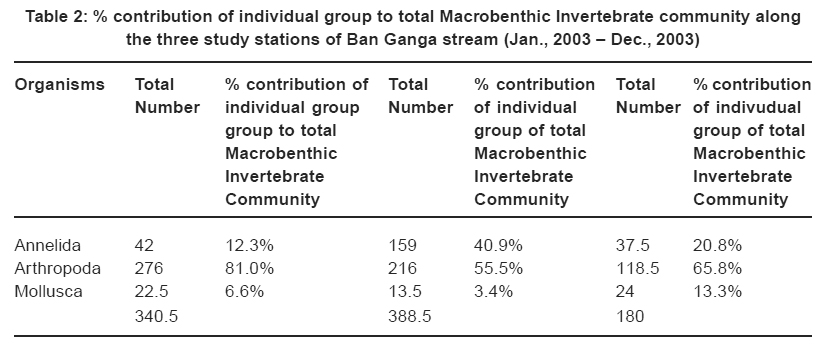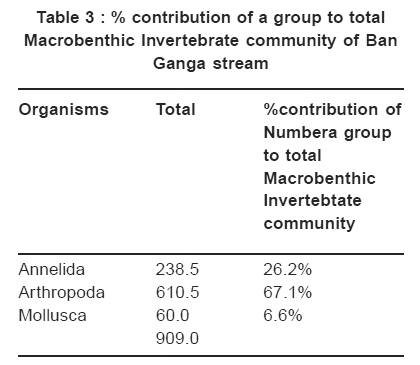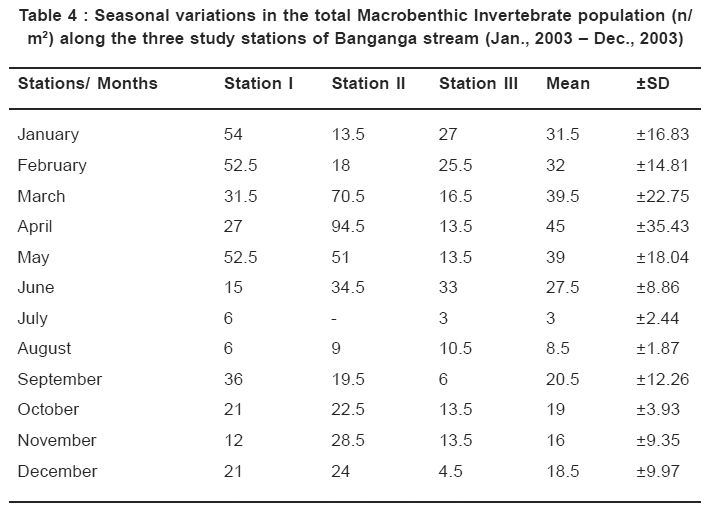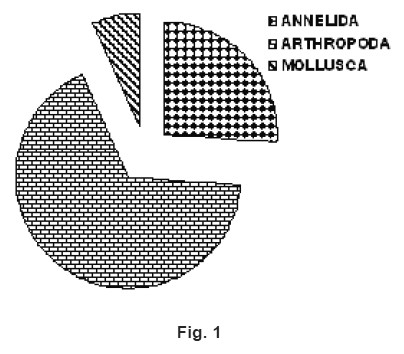Population dynamics of macroinvertebrates in a Shivalik stream, Banganga, Katra (J & K)
K.K. Sharma1 * , Nitasha Sawhney1 , Mediha Shafiq1 and Rajinder Singh1
1
Department of Zoology,
University of Jammu,
180 006
India
DOI: http://dx.doi.org/10.12944/CWE.2.2.10
Prudent management of lotic systems requires information on their ecological status that can be estimated by monitoring water quality and biodiversity attributes. To understand the environmental conditions in Ban Ganga stream (Katra), a study was carried out to establish the relationship between water quality and macroinvertebrate assemblages between the months of Jan. and Dec., 2003. Water physico-chemical characteristics (temperature, depth, speed, pH, DO, FCO2, CO3", HCO3", Ca++, Mg++ and Cl-) and biodiversity index changed markedly along the longitudinal profile of stream. In total, 13 species of phylum Annelida, Arthropoda and Mollusca were recorded. The highest number of species (12) were observed at S-I and lowest number (10) at S-III. The order of dominance of various groups was as : Arthropoda > Annelida > Mollusca. Moreover, the highest species diversity index of 5.157 was recorded at S-II and the lowest 4.151 at S-III. Thus, the present study indicated that significant changes in aquatic macroinvertebrate assemblages were primarily due to water quality rather than prevailing climatic conditions.
Copy the following to cite this article:
Sharma K.K, Sawhney N, Shafiq M, Singh R. Population dynamics of macroinvertebrates in a Shivalik stream, Banganga, Katra (J & K). Curr World Environ 2007;2(2):165-170 DOI:http://dx.doi.org/10.12944/CWE.2.2.10
Copy the following to cite this URL:
Sharma K.K, Sawhney N, Shafiq M, Singh R. Population dynamics of macroinvertebrates in a Shivalik stream, Banganga, Katra (J & K). Curr World Environ 2007;2(2):165-170. Available from: http://www.cwejournal.org/?p=671
Download article (pdf) Citation Manager Publish History
Select type of program for download
| Endnote EndNote format (Mac & Win) | |
| Reference Manager Ris format (Win only) | |
| Procite Ris format (Win only) | |
| Medlars Format | |
| RefWorks Format RefWorks format (Mac & Win) | |
| BibTex Format BibTex format (Mac & Win) |
Article Publishing History
| Received: | 2007-10-08 |
|---|---|
| Accepted: | 2007-11-30 |
Introduction
Studies have shown that water quality in aquatic systems has strong impact on biological components (Harding et al., 1999; Ometo et al., 2000). According to river continuum concept, community structure and function conform with certain geomorphic, physical and biotic characteristics such as stream flow, channel morphology, detritus loading, size of particulate organic matter, autotrophic production and thermal loading (Vannote et al., 1980). However, this concept seldom holds in many lotic systems due to longitudinal changes in environmental conditions caused by agricultural, human settlements or industrial activities (Roy et al., 2003).
Macroinvertebrates constitute an important component of biodiversity in lotic systems (Merritt and Cummins, 1996). They are diverse, have short generation times and are easily dispersed. As a group, macro-invertebrates are sensitive and respond to both natural and anthropogenic changes in their environment (De Pauw and Hawkes, 1993). Several techniques, protocols and indices have been developed to monitor stream quality using changes in species composition, diversity and functional organization of its inhabitants (Lenat, 1993). (Pielou, 1975) observed that the concept of biodiversity (species richness and evenness) is a central theme ecosystem ecology and can be used to explain properties such as biological productivity, habitat heterogeneity, habitat complexity and disturbance. Species diversities are moderate in stable ecosystems, highest in intermediate and low in severely degraded ecosystems (Connell, 1978). High species diversity in moderately disturbed ecosystem is attributed to stress tolerant and pioneer species.
In India and particularly in Jammu and Kashmir, only few studies have been attempted to describe the structure and composition of macroinvertebrates in lotic systems (Dutta and Malhotra, 1986; Sunder and Subla, 1986; Zutshi, 1992; Thakial, 1997; Sharma, 1999 and Sawhney, 2004).
Therefore, the study was sought to investigate water quality and macroinvertebrate community in Ban Ganga stream (Katra). The main objectives of the study were
-
Determination of water physico-chemical characteristics;
-
Description of macroinvertebrate composition; and
-
Correlation of water quality to macroinvertebrate densities and biodiversity indices along the stream.
 |
Table 1: Range of various physical-chemical parameters the Banganga Stream, Katra (Jan. 2003-Dec., 2003) Click here to view table |
Material and Methods
Study Area
The study was carried on Ban Ganga stream (Katra) in Jammu (India) for a period of 12 months (Jan. – Dec., 2003). Ban Ganga; a shallow stream originating from the snow bound hills of Shri Mata Vaishno Devi meets mighty river Chenab after traversing through Katra town. The stream is the main source of water supply to the inhabitants of Katra town and its suburbs. As soon as the stream passes through Charan paduka, it receives various effluents in the form of runoff from dhabas, excreta from ponies, wastes from kitchen (Gulshan langar), municipal sewage, flour balls and waste from crematorium. All these influence both water quality as well as aquatic ecology. For the present study, three sites were established along the longitudinal profile of stream. Site I was under least anthropogenic influence whereas, site II at a distance of 1 Km from S-I was the site under maximum urban influence and S-III, 3 Km downstream from S-I receive pollutants in the form of sewage, pony dung; etc.
Water samples and macroinvertebrates were collected monthly for a period of 12 months. All the physico-chemical parameters were analysed using APHA (1985). Macroinvertebrates were sampled using Ekman’s dredge and were then sieved through sieve (No. 40 mesh size 0.02 mm - 0.05mm). Organisms collected were preserved in 4% formalin for identification. These were identified using Ward and Whipple (1959), Tonapi (1980) and Pennak (1989). The number of organisms per square meter was counted using formula.

Species divesity index (Shannon-Weiner index) was calculated using formula.


Results and Discussion
 |
Table 2: % contribution of individual group to total Macrobenthic Invertebrate community along the three study stations of Ban Ganga stream (Jan., 2003 – Dec., 2003) Click here to view table |
Types and Quantities of Benthic Fauna
A total of 13 species of 3 phyla namely Annelida, Mollusca and Arthropoda were found during investigative studies on Banganga Stream (Katra). The average density from all the sites was 75.75n/mS2. The average density of S-I was 28.37n/__Hm=2, -S-II was(pi)32log.37n/m=pu2and S-III was 15.00n/m2. The lowesti=1 density of benthos at S-III (15.00n/m2) may be due to the decreasing DO concentration and increasing pH (Rosillon, 1989) whereas, the highest macrobenthic invertebrate density encountered at S-II may be due to lentic-like conditions created due to embankment which has resulted in the accumulation of allochthonous material thereby, enriching the site and resulting in higher species diversity (Dutta and Malhotra, 1986; Thakial, 1997; Sharma, 1999; Sharma, 2002 and Singh, 2004).
The highest number of macrobenthic invertebrates at S-I may be due to the availability of optimal conditions (Dissolved Oxygen, temperature, water velocity and clean water) Table 1.
 |
Table 3: % contribution of a group to total Macrobenthic Invertebrate community of Ban Ganga stream Click here to view table |
 |
Table 4: Seasonal variations in the total Macrobenthic Invertebrate population (n/m2) along the three study stations of Banganga stream (Jan., 2003 – Dec., 2003) Click here to view table |
Dynamic Structure and Influence of Seasonal Variation of Benthic Fauna.
Phylum Arthropoda seems to have the highest influence to the alteration of total benthic fauna since it was the dominant phylum found all year as shown in the Table 2 and 3. The most abundant organisms among arthropods were dipterans represented by three species viz. Chironomous sps., Tabanus sps. and Pentaneura sps. Moreover, Chironomous sps. recorded its abundance at S-II which may be attributed to the increased entry of pollutants through various sources (Reid and Wood, 1976; Khajuria, 1992 and Sharma, 1999). That Chironomous prefers polluted zones of stream and could be regarded as pollution indicator (Armitage and Blackburn, 1985). Phylum Annelida was represented by class Oligochaeta (3 sps.) and class Hirudinea (1 sp.) whereas, phylum Mollusca was represented by two species of class Gastropoda.
Oligochaetes among Annelida constituted another group dominating the total macrobenthic fauna of Ban Ganga stream. Abundance of oligochaetes may be attributed to temperature, organic matter and flow of water (Learner et al., 1971; Hawkes, 1979; Gopal and Sah, 1993 and Pennak, 1989).
 |
Figure 1 Click here to view figure |
Phylum Arthropoda contributed maximally with an average of 67.1% to the total macrobenthic fauna of Ban Ganga stream followed by Annelida (26.2%) and Mollusca and (6.6%) respectively (Table 3, Fig. 1). The rapidly increasing pop of Chironomidae might have led to arthropod dominance. Habitat stability and biotic interactions could be a dominant force in structuring benthic community in streams (Ometo et al., 2000).
A look at the Table 4 reveals that quantit-atively, total macrobenthic fauna recorded its minima in the month of July (monsoon season) due to heavy influx of water inform of floods and maxima recorded during summer months may be due to increased DO and temperature which may have favoured the production of organic matter thereby, leading to the growth of benthic fauna (Bhatt et al., 1984; Strommer and Smock, 1989; Thakial, 1997 and Sharma, 1999).
Diversity Index of benthic Fauna
Along the longitudinal profile of stream, diversity index value was highest in the middle (5.157) compared to the values recorded upstream (4.486) and downstream (4.151). The average diversity index of the stream was 4.59 which indicated the poor quality of water (Warren, 1971).
Thus, it can be concluded that the quality of water in upstream (S-I) and downstream (S-III) was good to fair, but in S-II (middle) was poor.
References
-
APHA. Standard methods for the examination of water, 17th Ed. American Public Health Association (1985).
-
Armitage, P.D. and Blackburn, J.H. Chironomidae in a Pennine stream systems receiving mine drainage and organic enrichment. Hydrobiologia. (1985) 121: 165-172.
-
Bhat, S.D., Bisht, Y. and Negi, U. (1984). Ecology of the limnofauna in river Kosi of the Kumaun Himalaya (Uttar Pradesh). Proc. Indian Natn. Sci. Acad. 50(4): 395-405.
-
Connell, J.H. Diversity in tropical rain forests and coral reefs. Science. (1978) 199: 1302-1310.
-
De Pauw, N. and Hawkes, H.A. Biological monitoring of river water quality. In: River Water Quality Monitoring and Control (Eds W.J. Walley and S. Judd). Aston Unviersity, Birmingham. UK (1993).
-
Dutta, S.P.S. and Malhotra, Y.R. Seasonal variations in macrobenthic fauna of Gadigarh stream, Miran Sahib, Jammu. Ind. J. Ecol. (1986) 13(1): 138-145.
-
Gopal, B. and Sah, M. Conservation and Management of rivers in India: Case study of the river Yamuna. Environmental Conservation. (1993) 20(2): 243-253.
-
Harding, J.S., Young, R.G., Yaes, J.W., Shearer, K.A. and Stark, J.D. Changes in agricultural intensity and river health along a river continuum. Freshw. Biol. (1999) 42: 345-357.
-
Hawkes, H.A. Invertebrates as indicators of river water quality. In: Biological indicators of water quality (Jones, A. and Evison, L. eds.) (1979).
-
Khajuria, A. Studies on the nekton and benthos of Lake Mansar. Ph. D. Thesis, University of Jammu (1992).
-
Learner, M.A., Williams, R., Horcap, M. and Hugher, B.D. A study of the macrofauna of the river Cyon , a polluted tributary of the river Taff (South Wales). J. Fresh water Biol. (1971) 339-376.
-
Lenat, D.R. A biotic index for the southeastern United States: derivation and list of tolerance values, with criteria for assigning water quality ratings. J.N. Am. Benthol. Soc. (1993) 12: 279-290.
-
Merrit, J.W. and Cummins, K.W. An introduction to the aquatic insects of North America, 3rd edn. Kendall/ Hunt, Dubuque, I.A (1996).
-
Ometo, J.P.H.B., Martinelli, L.A., Ballester, M.V., Gessner, A., Krusche, A.V., Victoria, R.L. and Williams, M. Effects of land use on water chemistry and macroinvertebrates in two streams of the Piracicaba river basin, Southeast Brazil. Freshw. Biol. (2000) 44: 327-337.
-
Pennak, R.W. Freshwater invertebrates of the united states (Protozoa- Mollusca) 3rd Edn. A Wiley Interscience Publication. John Wiley and Sons, New York, USA (1989).
-
Pennak. R.W. Freshwater Invertebrates of the United states (Protozoa-Mollusca) 3rd Edition. A Wiley Inter Science Publication. John Wiley and Sons Inc. 628pp (1989).
-
Pielou, E.C. Ecological Diversity. Wiley-Interscience. New York, US (1975).
-
Reid, G.K. and Wood, R.D. Ecology of Inland Waters and Estuaries (second edition). D. Van Nostrand and Co. New York. 485 (1976).
-
Rosillon, D. The influence of abiotic factors and density-dependent mechanisms on between-year variations in a stream invertebrate community, Hydrobiologia. (1989) 179: 25-38.
-
Roy, A.H. Rosemond, A.D., Leigh, D.S., Paul M.J. and Wallace, J.B. Habitat specific responses of stream insects to land cover disturbance: biological consequences and monitoring implications. J.N. Am. Benthol. Soc. (2003) 22(2): 292-307.
-
Sawhney, N. Limnological assesment of Ban-Ganga stream reference to some consumers inhabiting the stream. M.Phil. Dissertation. University of Jammu (2004).
-
Sharma, A. Limnological studies of Ban-Ganga and distributional pattern of stream bottom fauna. Ph.D. thesis, University of Jammu (1999).
-
Sharma, A. Limnological studies of Ban-Ganga and distributional pattern of stream bottom fauna. Ph.D. thesis, University of Jammu (1999).
-
Sharma, S. Studies on the impact of anthropogenic influences on the ecology of Gharana wetland, Jammu. Ph.D. thesis, University of Jammu (2002).
-
Singh, P. Faunal diversity of some wetlands of Jammu. Ph.D.thesis. University of Jammu (2004).
-
Strommer, J.L. and Smock, L.A. Vertical distribution and abundance of invertebrates with in the study substrate of a low gradient head water stream. Fresh Water Biology. (1989) 22: 263-274.
-
Sunder, S. and Subla, B.A. Macrobenthic fauna of a Himalayan river. Indian J. Ecol. (1986) 13(1): 127-132.
-
Thakial, M.R. Studies on benthos in some habitats of Jammu. Ph. D. Thesis, University of Jammu, Jammu (1997).
-
Tonapi, G.T. Freshwater invertebrates of India (an ecological approach). IBM and oxford publication, New Delhi, India (1980).
-
Vannote, R.L., Minshall, G.W., Cummins, K.W. Sedell, J.R. and Cushing, C.E. The river continuum concept. Can. J. Fish. Aquat. Sci. (1980) 37(1): 130-137.
-
Ward, H.B. and Whipple, G.C. Freshwater Biology. John Wiley and Sons Inc., New York, London and Sydney. 1243 (1959).
-
Warren, C.E. Biology and water pollution control. W.B. Saunders Company, Philadelphia, London and Toronto, (1971) 16: 434.
-
Welch, P.S. Limnological Methods, Philadelphia, McGraw Hill Co., New York (1948).
-
Zutshi, N. Effect of Jammu city sewage on abiotic and biotic factors of river Tawi, Jammu. Ph.D. thesis, University of Jammu, Jammu (1992).







